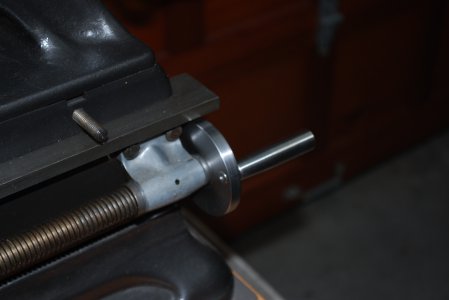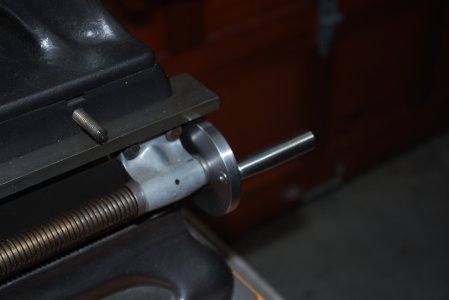I started a small project that needed me to be able to trust the calibration of the hand wheel dial that moves the apron back and forth.
The dial is labeled as .75" per revolution and has .01" markings.
I started to make measurements of how far the apron actually moved when I turned the hand wheel one revolution. I got all sorts of inconsistent results. I used a ruler, gauge blocks, calipers. I did it over short distances, long distances. And the numbers came back all over the place. Sometimes the apron seemed to move .8" and other times .7" Yeah--all over the place. (Yes, I was always careful about backlash). Any particular measurement though was consistent--it repeated when I set it all up the same way. Sometimes I moved the apron 16 full revolutions (for a nominal of 12") and it would be short by more than .1" (See snapshot--the 12" caliper has not closed yet even though it started at 12" and had at that point done exactly 16 full revolutions.)
Finally I ran a careful calibration run. Set up my 12" caliper and read it every .1" nominal from the hand wheel dial. WOW! It really is way off.
There is really significant drift--on average the apron moves 1.2% less than the hand wheel dial says. This is pretty close to .4/25.4 so perhaps the hand wheel actually moves the apron 25 mm when it says it has moved it 1 inch.
BUT ALSO, there is major periodic error. Period is 2.675". Peak-to-peak of .074". Meaning sometimes the apron has moved .037" more than the continual drift indicates it should have and then 1.3375" later it is reading .037" less than the drift adjustment says it should have.
The very strong periodic error surprised me. The drift error makes the lathe hand wheel dial much less useful, but at least it can be adjusted for. But, keeping track of where in the periodic error I am along the lathe is way too much puzzling for me to ever do.
So, questions:
Thanks for any guidance you might have.
-Bill



The dial is labeled as .75" per revolution and has .01" markings.
I started to make measurements of how far the apron actually moved when I turned the hand wheel one revolution. I got all sorts of inconsistent results. I used a ruler, gauge blocks, calipers. I did it over short distances, long distances. And the numbers came back all over the place. Sometimes the apron seemed to move .8" and other times .7" Yeah--all over the place. (Yes, I was always careful about backlash). Any particular measurement though was consistent--it repeated when I set it all up the same way. Sometimes I moved the apron 16 full revolutions (for a nominal of 12") and it would be short by more than .1" (See snapshot--the 12" caliper has not closed yet even though it started at 12" and had at that point done exactly 16 full revolutions.)
Finally I ran a careful calibration run. Set up my 12" caliper and read it every .1" nominal from the hand wheel dial. WOW! It really is way off.
There is really significant drift--on average the apron moves 1.2% less than the hand wheel dial says. This is pretty close to .4/25.4 so perhaps the hand wheel actually moves the apron 25 mm when it says it has moved it 1 inch.
BUT ALSO, there is major periodic error. Period is 2.675". Peak-to-peak of .074". Meaning sometimes the apron has moved .037" more than the continual drift indicates it should have and then 1.3375" later it is reading .037" less than the drift adjustment says it should have.
The very strong periodic error surprised me. The drift error makes the lathe hand wheel dial much less useful, but at least it can be adjusted for. But, keeping track of where in the periodic error I am along the lathe is way too much puzzling for me to ever do.
So, questions:
- Is this 1.2% error to be expected in the PM1030V? I had thought it was an inch machine. What is the explanation? Can it be fixed?
- Is the large periodic error to be expected in the PM1030V? Does it happen in other hobby lathes? Is it a bug in my particular lathe? Can it be fixed?
Thanks for any guidance you might have.
-Bill



